
When we want the flavors of bulgogi and the convenient outdoor grilling method of a burger, there’s an easy solution: combine them. By sticking with the tried-and-tested burger, glazing it with a spicy soy-ginger-garlic-gochujung sauce, and stacking it with kimchi mayo and pickled daikon radish, you can keep the best of both worlds without offending culinary purists.
This recipe was originally written for Serious Eats.
We’ve all experienced what I like to call “fusion fails”. Two culinary concepts which, taken individually, are perfectly respectable, but in combination create a whole that is … let’s just say less than the sum of its parts. For example, I love fruit, I love cheese, but bits of fruit IN cheese? No thank you. I love bacon, and I’m a fan of vodka, but bacon-flavored vodka (yes, this exists)? I’ll pass. The most successful fusions take two examples which aren’t so far separated on the food spectrum that you have to take a leap of faith that the result is even edible, let alone worth the trouble of combining them. Croissants and doughnuts can at least both be found on the bakery shelf, and thus we have the cronut. And bulgogi, the Korean staple, uses thin strips of beef that are marinated and seared, so why not apply those flavors to a perfectly grilled burger? To be honest, making up names like “cronut” and “flagel” isn’t our forte, so we’re simply calling this the “bulgogi burger”. If you’re as nerdy as we are, you might like to call this a “crossover episode” – where stars from two different shows team up to make a delicious dinner! (This is why we don’t write TV shows.)
But here’s why we rate this a success: we don’t mess with the flavors of bulgogi, and we don’t mess with the essential technique of making and grilling a perfectly juicy burger. We love them both, so why compromise?
If all this sounds familiar, it’s because bulgogi stands up to a little adaptation – earlier this year we successfully folded it into a burrito. And of course, we love the classic version as well, especially when served with crisp lettuce and our favorite Red Cabbage Salad With Spicy Miso-Ginger Dressing.
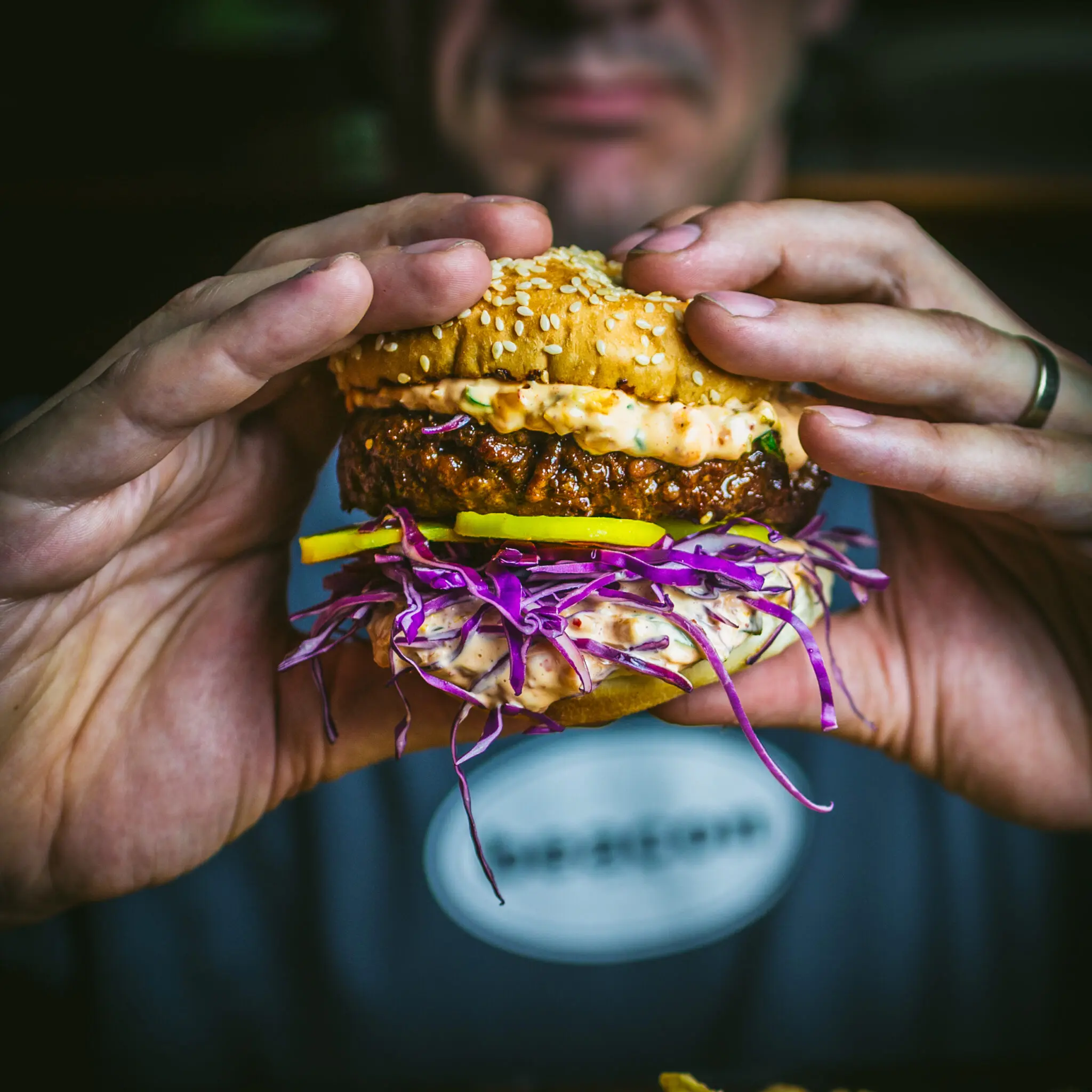
Bulgogi is all about combining the flavors and textures of its constituent elements, so we want to do proper justice to bulgogi burgers. We certainly didn’t invent this dish — you’ll find versions of it not only in Korea, but in most Koreatowns — but this is the version of bulgogi burgers that we make most often.
Let’s start with the star of the show – the beef – the classic bulgogi recipe uses a marinade to let the assertive flavors of soy, ginger, garlic, and (not traditional in bulgogi, but delicious) gochujang soak in and help tenderize it. In this case, we don’t want to change the texture of the meat (you’d end up with some kind of Korean sloppy joe, which actually does sound kind of delicious, but not what we’re after here). Instead, keep the meat very cold and handle it as little as possible. Just enough to divide it easily and form patties. Remember to make an indent with your thumb to keep the patties from bulging as they cook.
Once the burger is fully seared on the grill, but before we remove it from the heat, we glaze it with our homemade bulgogi sauce. On a charcoal grill, we use direct cooking over the coals to do the initial sear, and once the outside is nicely charred, we move it to indirect heat (off the coals) and baste and flip the patty a few times while it continues to cook. Keep an eye on the temperature of the meat with an instant-read thermometer. Our preference is for a medium-rare burger, and so we move it from direct to indirect heat once the inside hits 110°F, and cook over indirect until it reaches 120°F. Add 10 degrees to those numbers if you prefer your burger medium. Either way, let it sit for five minutes once it’s off the grill, since the interior temperature will continue to rise.
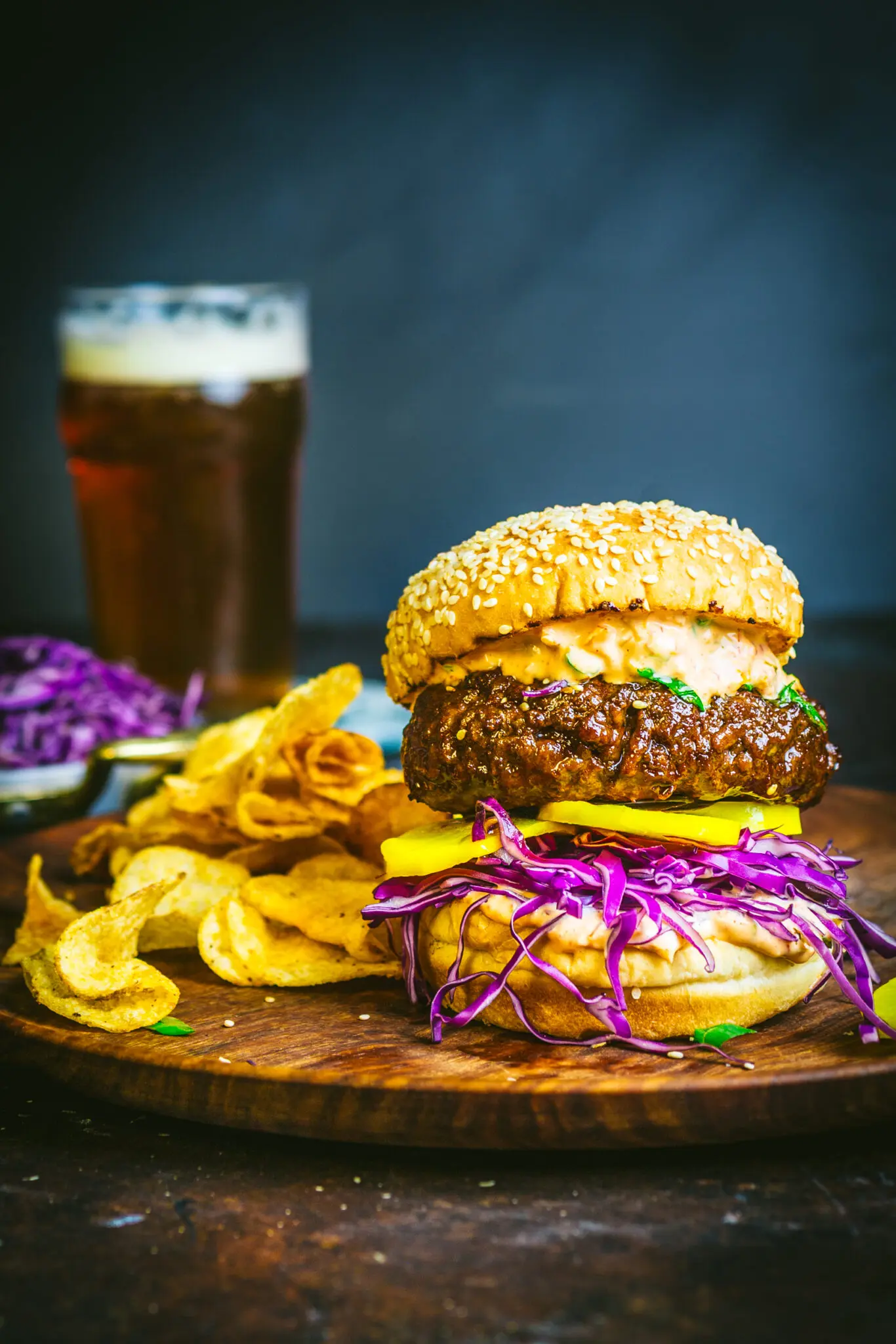
But before you even handle the meat (hehe), you’re going to want to prepare your sauces and toppings (well, bottomings, really). There are three main flavor elements to this burger: the bulgogi sauce, the daikon radish pickles and the kimchi mayo.
You’ll want to make the pickled daikon radish (or danmuji, also called takuan in Japanese cuisine) first, because they’ll need to sit in the brine for at least a few hours to absorb the tangy pickle flavors and color from the turmeric. You can also make them up to a week ahead and keep them refrigerated.
Then you can move on to the kimchi mayo. In our opinion, kimchi is a non-negotiable part of bulgogi – pretty much any Korean meal, actually – and here we’re using it to make a spicy sauce. We use both finely chopped cabbage and some of the brine, along with a little grated garlic, sesame oil, and some finely chopped scallions. The result is pretty addictive. We slather it on both sides of the burger bun, but if you plan to serve up your burger up with fries, kimchi mayo makes an excellent dipping sauce! You can prepare it a day or two ahead, but plan on giving it at least half an hour to sit in order to let the flavors meld.
The bulgogi sauce itself is pretty straightforward. It’s the classic mix of soy, sugar, garlic and ginger, but we add a little gochujang (Korean spicy bean paste) and also reduce it a bit on the stovetop so it thickens a little. This helps it stick to the burger so it will really take in the flavor. Note that the sesame oil is added after the sauce is reduced, to best preserve its flavor.
Once the sauces and radish pickle are done, all you have left to do is finely shred some red cabbage. And you know when we said we weren’t going to mess with the bulgogi? Well, fine, we’re messing with it just a little. You won’t find red cabbage served with a traditional bulgogi, but we think its crunch and slight bitterness are a worthy addition to the burger assembly (we also use it in our Korean burritos). A few finely sliced scallions and some toasted sesame seeds are the final touch.
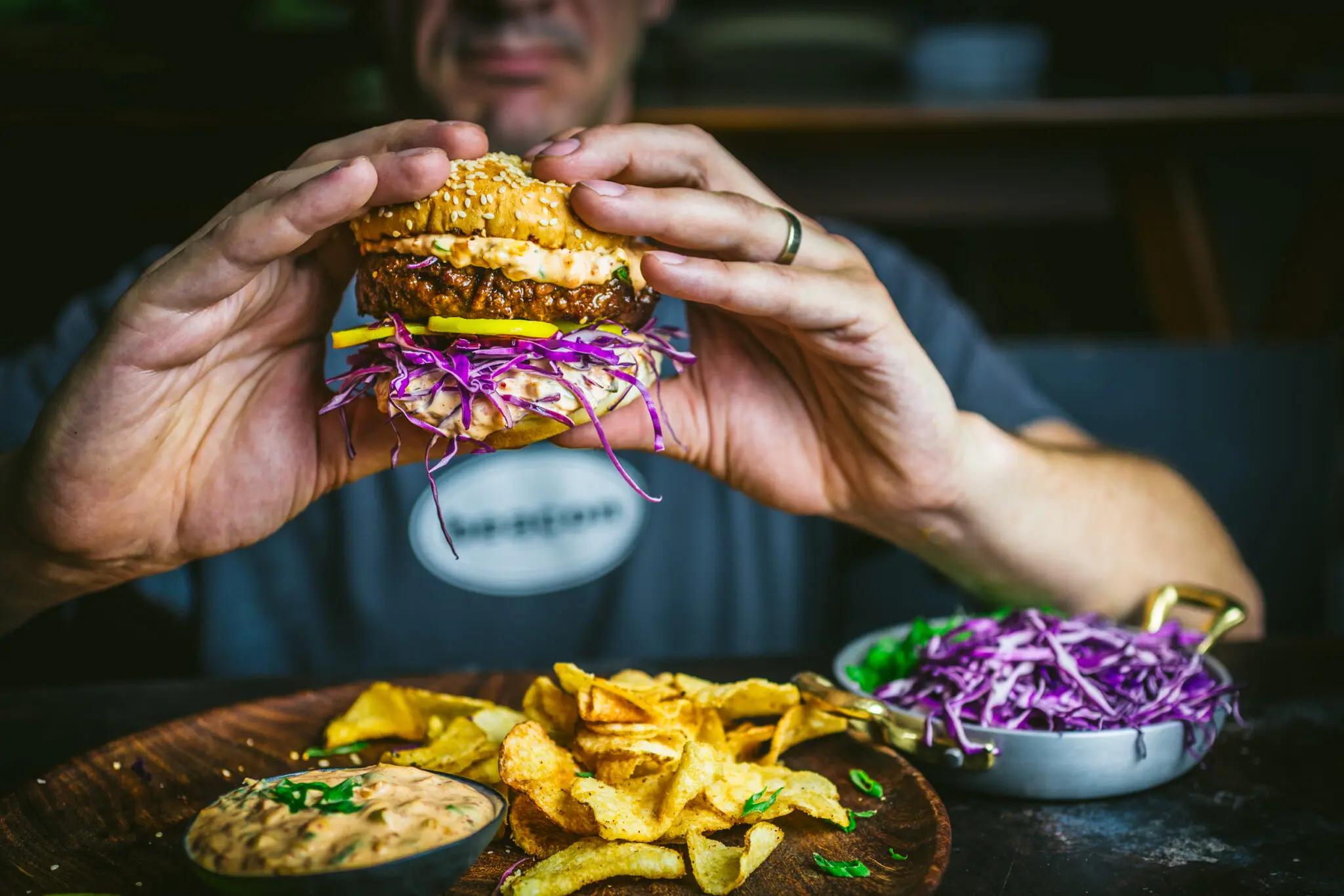
Now it’s time to grill and glaze your bulgogi burgers. While the burgers are resting, grill your buns (if you’re a toasted-bun fan, which we are; it helps them hold up better to being slathered with kimchi mayo and juicy beef). And then assemble and enjoy!
If you have a lot of cabbage and kimchi mayo left over, you can mix them together to make a tasty slaw. Serve your bulgogi burgers with potato chips, fries, or whatever sides you like. You probably won’t want ketchup (but if you add a slice of American cheese, we won’t judge you). You will, however, need a lot of napkins.
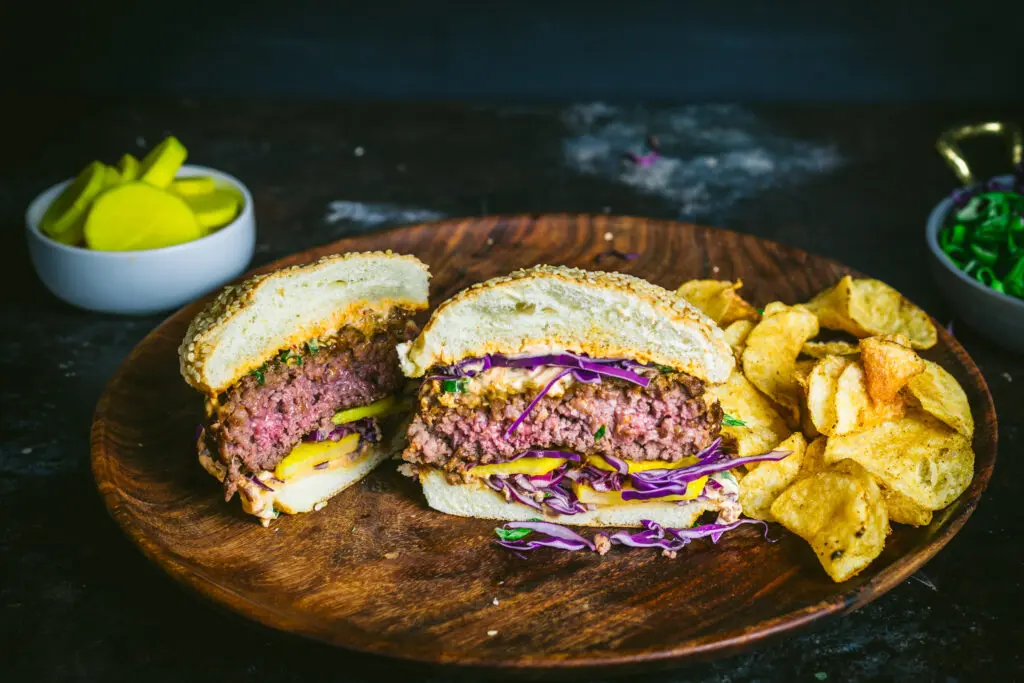
Bulgogi Burgers with Kimchi Mayo
Ingredients
For the danmuji:
- 1 1/2 cups 355ml water
- 1 1/2 cups 355ml unseasoned rice vinegar
- 1/2 cup 100g sugar
- 1 tablespoon 15g kosher salt
- 2 garlic cloves halved lengthwise
- 1 teaspoon turmeric powder
- 15 whole black peppercorns
- 2 bay leaves
- 1 pound 450g daikon radish, peeled and cut into thin rounds
For the Bulgogi Sauce:
- 1/2 cup 120ml soy sauce
- 1 1/2 tablespoons 20ml gochujang (spicy Korean red pepper paste)
- 3 garlic cloves grated or minced (about 15g)
- 1 tablespoon grated ginger
- 1 tablespoon 15ml rice wine vinegar
- 1/4 cup 50g brown sugar
- 2 teaspoons 10ml toasted sesame oil
For the Kimchi Mayo:
- 1 cup 215g mayonnaise
- 2 tablespoons 30ml kimchi brine
- 1/2 cup finely diced kimchi 100g
- 1 teaspoon 4g sugar
- 1 tablespoon 15ml toasted sesame oil
- 1 small garlic clove grated or minced (about 4g)
- 2 scallions finely chopped (about 40g)
- 1 1/2 pounds 680g fresh ground beef chuck (about 80% lean)
- Kosher salt to taste
- Vegetable oil for brushing the grill
- 2 tablespoons 10g toasted sesame seeds
- 4 sesame seed buns split
- 2 cups about 200g finely shredded red cabbage
Instructions
- Make-ahead (at least a day if possible) danmuji: Mix water, vinegar, sugar, salt, garlic turmeric, peppercorns and bay leaves in a medium pot and bring to a boil, stirring until the the sugar is melted. Turn off the heat and add the radishes. Let cool to room temperature (1 to 2 hours). Transfer pickles and brine to an airtight glass container and store in the refrigerator. Pickles will last up to a month or so.
- To make the sauce: Mix soy sauce, gochujang, garlic, ginger, vinegar, and brown sugar together in a small saucepan. Bring mixture to a boil over medium-high heat, reduce to a simmer, and cook until thickened enough to coat a spoon, about 5 to 7 minutes. Remove from heat, add 2 tablespoon sesame oil and let cool. Use immediately or store in an airtight container in the refrigerator.
- For the Kimchi Mayo: add mayonnaise, kimchi brine, kimchi, sugar, sesame oil, garlic, and scallions to a bowl and mix until combined. Refrigerate until ready to use.
- Form beef into 4 patties, about 1/2 inch wider than the burger buns. Press with your thumb to make a slight depression in the center to account for bulging as they cook. Season generously with salt and refrigerate until ready to cook.
- Light one chimney full of charcoal. When all the charcoal is lit and covered with gray ash, pour out and arrange the coals on one side of the charcoal grate. Set cooking grate in place, cover grill, and allow to preheat for 5 minutes. Alternatively, set half the burners on a gas grill to the highest heat setting, cover, and preheat for 10 minutes. Clean and oil the grilling grate. Place burgers directly over hot coals, cover with vents open, and cook, turning occasionally, until burgers are well charred and the centers register 110°F on an instant-read thermometer for medium rare or 120°F for medium, 5 to 7 minutes total.
- Brush burgers on both sides with bulgogi sauce and continue cooking, flipping and brushing occasionally, until they register 120°F for medium rare or 130°F for medium. Remove from grill and brush with more sauce on both sides until well glazed and coated. Sprinkle with sesame seeds.
- Toast burger buns over grill until light golden brown. Spread bottom and top buns with kimchi mayonnaise. Divide half of cabbage over bottom buns. Top with cooked burgers. Brush with more bulgogi sauce. Top with remaining cabbage, close buns, and serve.

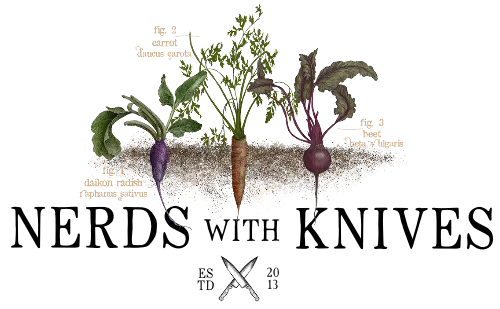
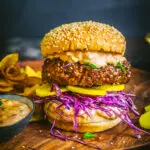
Woah woah woah woah. This looks like a burger sent straight from heaven, if such a thing existed. I mean, seriously, this thing packs a punch! Need to try this recipe soooon.
5